Big Skate
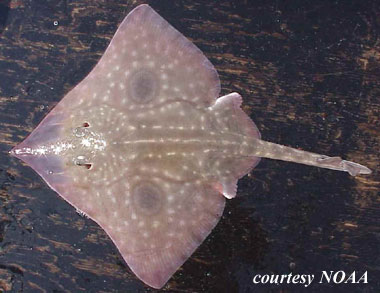
Raja binoculata
These diamond-shaped skates live in the colder waters of the northeastern Pacific, growing as large as almost 8 feet long from pointed snout to stout tail. Usually a mottled reddish-brown to dark grey on top, and scattered with small pale spots and larger dark blotches, they also have dark ‘eye spots’ on their pectoral fins, possibly to confuse predators about their size.
Although they prefer sandy or rocky bottoms, they have been found in kelp stands. They release large, leathery egg casings, and are one of the few skates to produce multiple embryos per egg case.
Order – Rajiformes
Family – Rajidae
Genus – Raja
Species – binoculata
Common Names
In the English language, the common name for this species is big skate. Other common names include gandah (Tsimshian), grote rog (Dutch), k’ak’ew (Salish), k’andah (Tsimshian), raie (French), raja wielka (Polish), raya gigante (Spanish) and scat (Russian).
Importance to Humans
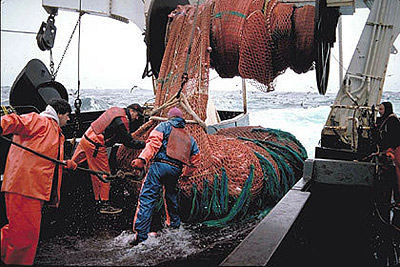
The big skate is of only minor commercial fisheries importance. However, it is taken incidentally as bycatch primarily by bottom trawlers in the waters off the coast of California (U.S.). The pectoral fins are sometimes marketed as “skate wings” and presumably as scallops (punched from the pectoral fins) although the flesh of skates is not highly regarded for human consumption. Anglers occasionally take this species, however it is usually released or discarded.
Historically, the skate fishery has been of only minor economic importance compared to other commercial fisheries. However, the market price of skate wings increased from $.01-$.02 per pound prior to 1970 to $.25 per pound in 1991. In the 1990s, the price ranged from $.40 to $1 per pound, making the skate a more attractive catch.
During the 1990s, the skate catch off the coast of California increased nearly ten-fold. This is in part due to the increased take by the trawl fishery which supplements its income by marketing skates and rays taken as bycatch. The impact on the populations of skates and rays due to the increased take is uncertain at this time.
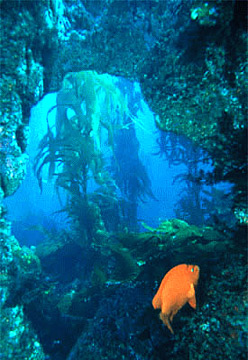
This species adapts well to captivity and small individuals are often displayed in public aquarium facilities.
Danger to Humans
The big skate is harmless to humans and will remain motionless on the bottom substrate near divers unless harassed.
Conservation
Although landings of skates are increasing in waters off the coast of California, it is difficult to assess how this impacts the current population level. The increased landings may or may not reflect a threat to this resource. In the past, the bycatch was discarded, however now these fish are being retained for market.
Skates mature at a late age, have slow growth rates, and low reproductive rates. All these factors make skates potentially vulnerable to over fishing and as such, warrant close monitoring of populations. In regions other than California, due to a reduction in landings, it appears that skates have been over fished and are suffering reduced population levels. One example, the barndoor skate (Raja laevis), is currently listed with the IUCN as vulnerable due to being severely over fished. However, population data is lacking to determine the exploitation of the big skate at this time.
> Check the status of the big skate at the IUCN website.
The IUCN is a global union of states, governmental agencies, and non-governmental organizations in a partnership that assesses the conservation status of species.
Geographical Distribution
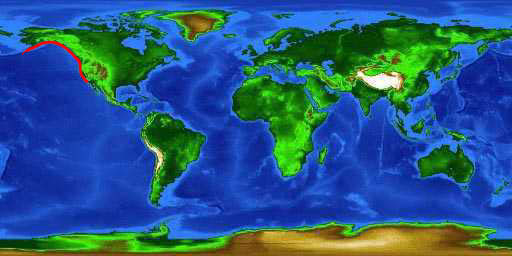
The big skate is found in temperate waters of the eastern Pacific Ocean between 63°N – 28°N latitudes. This range includes the eastern Bering Sea and Aleutian Islands, west to Unalaska Island and south to Baja, California (U.S.) near Cedros Island. This skate is rare south of Point Conception, California.
Habitat
In waters from the intertidal range to depths of 394 feet (120 m), the big skate is found along the coast in estuaries, bays, and over the continental shelf. Although this skate is sometimes observed in low stands of kelp, it is more common on sandy and muddy bottoms. It is usually seen hiding motionless in the bottom sediments with only eyes protruding, camouflaged from potential predators. When it does move, swimming occurs by the undulation of the pectoral fins, which makes the skate appear as though it is “flying” gracefully through the water.
Biology
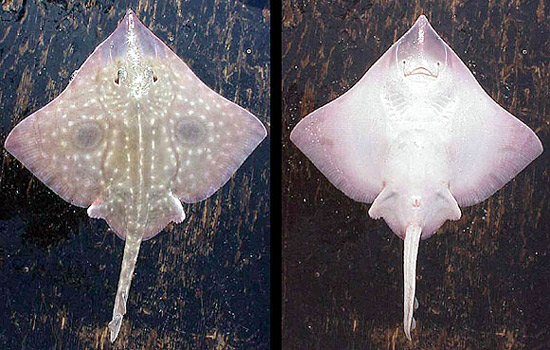
Distinctive Features
The big skate has a flattened diamond-shaped body with a stiff snout tapering to a blunt point. The small eyes are positioned on the dorsal surface some distance from the pointed snout with large spiracles just posterior to the eyes.
The mouth is on the ventral surface along with the five gill slits. The pectoral fins are not clearly distinct, attaching the snout with the body. These fins have a concave anterior edge between the snout and pointed tips of the fins. The two small dorsal fins are located on the tail while the anal and caudal fins are absent. The pelvic fins are large and moderately concave and weakly notched along the free margins. The tail is long and narrow and has a fleshy keel on either side.
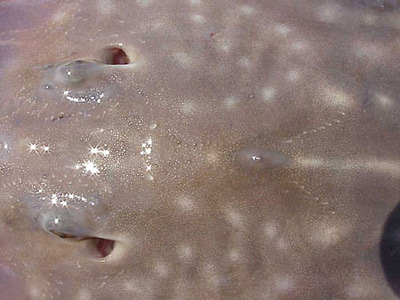
Species similar in appearance and sharing habitat with the big skate include:
California skate (R. inornata) which has a pointed snout, deeply notched pelvic fins, and slightly convex anterior edges of the pectoral fins.
Sandpaper skate (R. kincaidi) which lacks orbital thorns and has a thorn on the shoulders in center of body on each side of the midline of the skate.
Longnose skate (R. rhina) which has deeply concave anterior margins of the pectoral fins and deeply notched pelvic fins.
Starry skate (R. stellulata) which has small ocelli and convex anterior edges of the pectoral fins as well as is covered with thorns.
Roughtail skate (R. trachura) which has no large thorns on the body and is dark gray or black both on the dorsal and ventral surfaces.
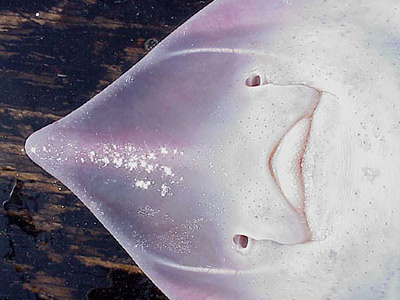
Coloration
The big skate has mottled coloration on the dorsal surface including brown, reddish brown, dark gray and black. There may also be small pale spots and scattered dark blotches. There are two large black spots, resembling eyes, on the dorsal surface of the pectoral fins. Each spot has a pale border and dark center. Biologists believe that these “eyes” may confuse potential predators, with the skate appearing much larger than it is. The ventral surface ranges from white to a muddy white sometimes with dark blotches.
Dentition
The teeth of the big skate are small. They are arranged in rows with bases touching and raised cusps.
Denticles
There is an irregular row of approximately 33 middorsal thorns that runs down the back and tail to the first dorsal fin. There is a single middorsal thorn located just behind the orbits. Also, orbital thorns are located between the eyes but may remain buried under the skin in some individuals. These thorns may become more prominent as the skate ages.
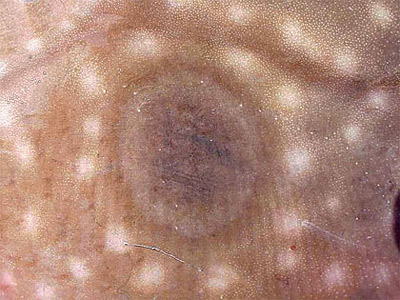
Small, placoid scales are present, although rather sparsely, on the body, tail and posterior portion of the head.
Size, Age, and Growth
Aptly named the “big” skate, this species is the largest skate in North American waters. The maximum reported size of the big skate is 7.9 feet (2.4 m) total length, however this species usually does not reach lengths beyond 6 feet (1.8 m) and weights of 200 pounds (91 kg). Males reach maturity at approximately 7-8 years of age and lengths of 3.2-3.6 feet (0.9-1.1 m); females mature at about 12-13 years of age and lengths of 4.3-4.6 feet (1.3-1.4 m).
Food Habits
The big skate feeds on marine invertebrates such as shrimp, worms, and clams as well as on fishes including the great sculpin (Myoxocephalus polyacanthocephalus).
Reproduction
The big skate is an oviparous, or egg-laying species. It has probably the largest egg capsules in the Rajidae family, with each measuring 9-12 inches (22.8-30.5 cm) long and 4-7 inches (11.0-19.4 cm) wide. The egg capsules are oblong in shape with horns at each corner. The only known egg capsules to contain more than one egg inside are those of the big skate and mottled skate (R. pulchra). The egg capsules of the big skate commonly contain 3-4 eggs, although up to 7 have been documented.
The female releases the egg capsules in pairs on sandy or muddy substrate. The egg capsules release the hatchlings about nine months after being released from the female. The empty black egg cases, referred to as mermaid’s purses, sometimes wash ashore and are found by beach walkers.
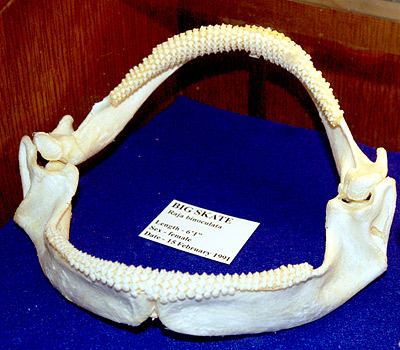
Predators
Large predatory bony fishes and sharks consume big skates. One such documented predator is the sevengill shark (Notorynchus cepedianus). The egg capsules are sometimes eaten by elephant seals.
Parasites
Copepods parasitize a variety of marine fishes with the big skate being no exception. The copepod Lepeophtheirus cuneifer sp. nov. is one such documented parasite of the big skate.
Taxonomy
The big skate was originally described by Girard in 1855 as Raja binoculata. Although another combination, Dipturus binoculata, was also used to describe the big skate, Raja binoculata remains the scientifically valid name. The genus name Raja is derived from the Latin “raja” meaning skate and the species name binoculata means two eyes, referring to the spots on the pectoral fins. A synonym used to refer to this species in previous scientific literature is Raja cooperi Girard 1858.
Prepared by: Cathleen Bester